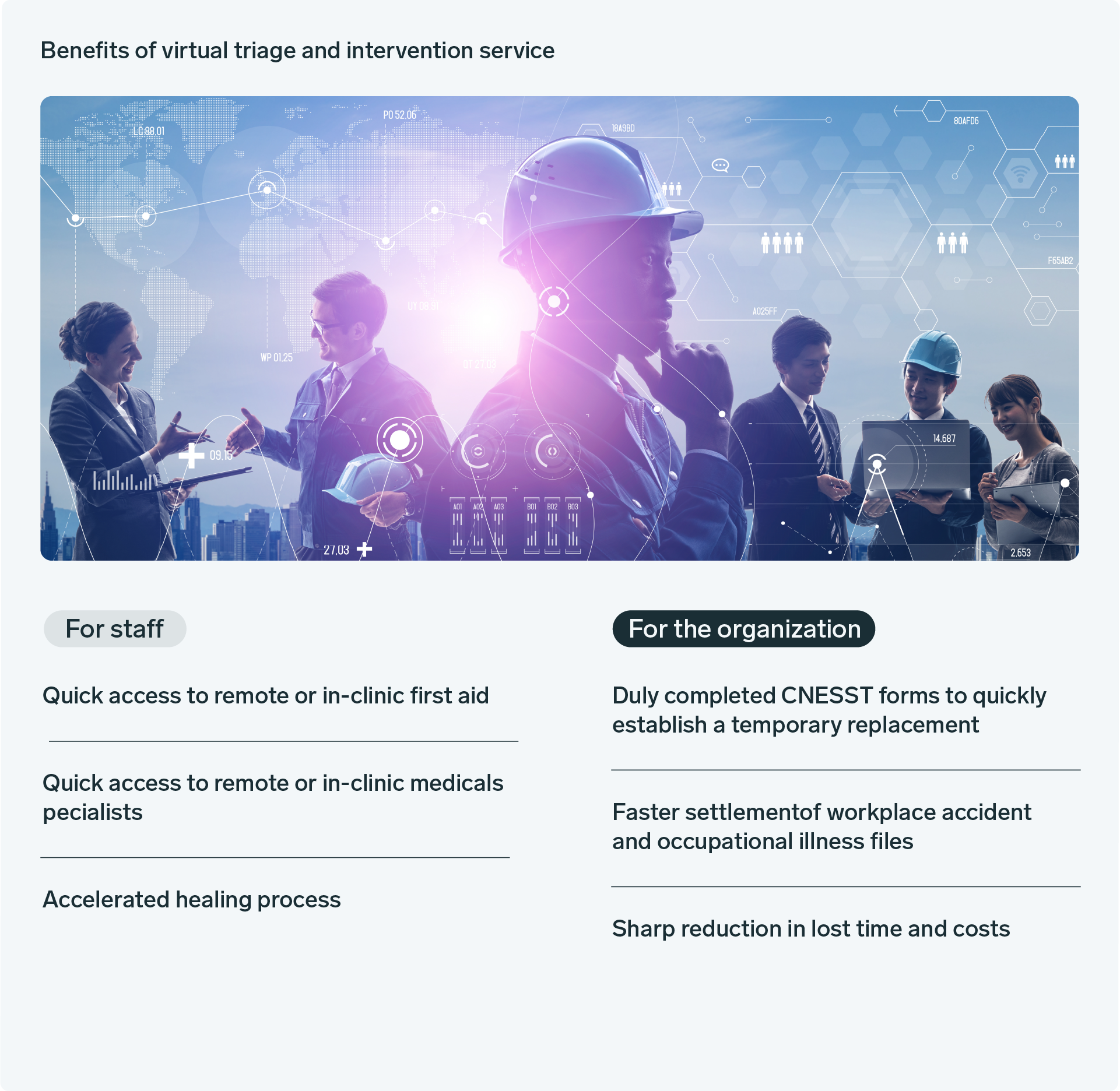Education Center — 8 minutes
Workplace accidents: What employers should know
In addition to the costs associated with medical expenses, sick leave and compensation, workplace accidents have serious human, social and financial consequences for companies. Reducing their impact is often a priority target, especially for companies in high-risk sectors. Here’s an overview of some aspects that managers and preventionists should take into account.

What are the employer’s responsibilities?
In Quebec, while employees are responsible for reporting an incident at work, the employer also has a number of duties.1
1. Provide assistance
The employer or its representatives must provide first aid to the injured person, including transporting the person to a hospital.
2. Record the event
It is mandatory to record all workplace accidents, even minor ones. This document will be an important factor if an investigation by the Commission des normes, de l’équité, de la santé et de la sécurité du travail (CNESST) is required.
3. Pay the first day of absence
If an employee must be absent from work because of an accident, the employer must pay the first day.
4. Pay an income replacement indemnity for the next 14 days
After paying the first day of absence, the employer must pay 90% of the employee’s net salary for the next 14 days. The employer can then make a claim to the CNESST for this amount.
5. Follow up
Then, although the worker is free to be treated and followed by the health professional of his or her choice, the employer can propose a resource to the worker. If the worker accepts to be followed by the resource proposed by the employer, the latter becomes the health professional in charge of the worker and the CNESST is bound by his opinion. In this case, the costs related to this medical follow-up must be paid by the employer.
What’s the impact on companies?
Direct and indirect costs
Workplace accidents have multiple consequences for companies. A survey conducted by the Institut de recherche en santé et en sécurité au travail (IRSST)2 revealed that the annual cost of work-related injuries in Quebec in 2016 was nearly $6 billion, or an average of $65,550 per injury.
To compensate victims, the CNESST collects a premium from companies, the rate of which is set based on the industry, as the number of workplace accidents varies according to each. In large companies, this insurance premium can also be adjusted up or down based on their claims performance.
In addition to the CNESST premium, other costs directly related to the incident may have to be paid by the employer. These include per diems, training costs for the replacement worker, or potential civil or criminal penalties. These are then added to all the indirect costs, such as the impact on productivity, the company’s reputation and employee morale.
Tricky situations

Unreported injuries
An employee should promptly notify his or her employer when a workplace accident occurs. However, some people may be reluctant to do so for a variety of reasons. To avoid this, and any potential deterioration of the injury, employers have an interest in reassuring and guiding their staff.
| Motifs | Solutions |
|---|---|
| I'm afraid of losing my job. | Staff should be informed that, by law, an employer cannot fire someone because they have suffered a workplace injury. In addition, employers have a legal obligation to provide a safe work environment for their employees. |
| Cela pourrait nuire à ma réputation ou à mon avancement professionnel.This could hurt my reputation or career prospects. | It is important to send the message that reporting an incident does not affect an employee’s career. |
| I didn't know. | Employers should clearly communicate the procedure to follow in the event of an incident. |
| It's complicated. | Providing adequate support to staff following an accident is essential. The employer should provide an easily accessible support service, offered by internal or external resources. For its part, the CNESST has established a simple and effective process for reporting work-related accidents. |
The case of temporary foreign workers
Quebec has seen an increasing number of workers from abroad, who are unfortunately well represented among the claims received by the CNESST every year. This, however, may be just the tip of the iceberg.
Language barriers, lack of knowledge of Canadian and Quebec rules and laws, and fear of losing their jobs are merely some of the reasons why certain foreign workers do not report an accident. Therefore, they should be a priority target for information and prevention for the companies that hire them.
For companies with head offices outside the country, there may be grey areas for their employees working in Canada. They do not always understand each person’s responsibilities in the event of an accident. It is important to clarify this.
The difficulties of subcontracting Ensuring compliance with preventive rules can become a real headache for companies that hire subcontractors who, in turn, sometimes do business with third parties.
This is often the case at construction sites, especially large ones. It is sometimes difficult for the project manager to impose a standard procedure on all parties involved. Unravelling each person’s responsibilities in the event of an accident can also be complex.
The proliferation of telework
Habits developed during the pandemic have transformed work patterns, and the enthusiasm of employees for telecommuting has profoundly changed the culture of some companies.
With the changes in rules, locations and even working hours, grey areas have emerged, and sometimes a climate of mistrust is created in the event of an incident. How can one be sure that a workplace accident can be considered as such without witnesses and evidence, especially if it occurs outside of working hours?
With telework, the line between work time and personal time is blurred. Rules that applied prior to the pandemic must therefore be reviewed for the organizations involved.
Prevention and innovation
Prevention has always been the spearhead in the fight against work accidents. With the explosion of human and financial costs related to workplace injuries, prevention remains an essential ally for businesses wishing to protect their employees and reduce their costs. Some sectors, particularly those in service industries such as transportation, manufacturing and trade,3 are more severely affected and will likely need to make this a priority in the coming years.
However, innovative services, such as early nurse triage, can also be valuable tools to quickly adapt to the new realities of the workplace, facilitate incident management and meet employee needs more effectively.
For professional support, we’re here for you.
Biron offers specialized triage, interventions and care for injured workers. Request a quote or information online, or call our specialized occupational health staff at 1 833 590-2716.

Sources3
- CNSST. Démarche de l’employeur lors d’un accident du travail [website], www.cnesst.gouv.qc.ca/fr/demarches-formulaires/employeurs/demarche-lemployeur-lors-dun-accident-travail (consulted April 5, 2023).
- Busque, M.-A., M. Lebeau, M.-A. Tremblay, A. Boucher, P. Duguay. Portrait statistique des lésions professionnelles indemnisées au Québec en 2015-2016, Montreal, IRSST, 225 p., www.irsst.qc.ca/media/documents/PubIRSST/S-1150-fr.pdf
- Crespo S. and S. Blouin. La CNESST en bref – année 2021, CNESST, 2022, 39 p., https://www.cnesst.gouv.qc.ca/sites/default/files/documents/cnesst-en-bref.pdf



